A major concern for parents of thumbsuckers is that their child will end up with the Thumbsucker's mouth. For those of us committed to a lifetime of thumbsucking pleasure, though, not having a mouth like some of the ones below may concern us more. After all, when the teeth move as a result of thumb sucking they do so to accommodate and make an already comfortable habit even more pleasurable to live with. As for appearance, well, that's a matter for each individual to decide. Personally, I like buck teeth.
Move quickly towards Cisco 640-461 exam through updated ccna certification cbt make sure that you get the things going right for the exam.
If you have contributions, attach them to your mail and click here to e-mail me.
Photos below
And an article...From the Dental Experts
An articlet...From Ancient Egypt
Read the contents of this page and if you're still not satiated? Check out more teeth by clicking below:
More Teeth 1
![]() (9/6/99)
(9/6/99)
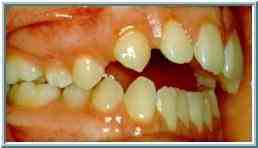
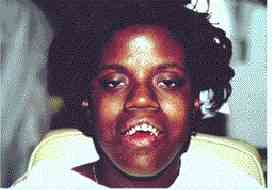
The one to the left is a sample of an "open bite" with overjet. The right photo is an extreme in open bites, an example where the teeth actually push against the lips, leaving them open in the postural resting position. An open bite is a condition where the occlusion doesn't meet with the mouth clenched shut, an overjet (usually misnamed as an overbite) is the amount of distance the teeth protrude forward. Note how advantageous this form of malocclusion is, enabling the Thumbsucker (in this case an adult) to have a comfortable place for their thumb. An individual with this dental structure could suck her thumb all night and not concern herself with "numb thumb" in the morning. The pictures below show that this pattern can occur in thumb habits, but if you are worried about it and you're an adult, chances are if you don't have this occlusion yet, you won't ever have it. Notice, too, the typical structure found in the lower front teeth (incisors). The indenting is due to the down and inward pressure vector of the thumb on these teeth. Again the teeth here are adapting by creating a more comfortable Thumbsucker's environment.
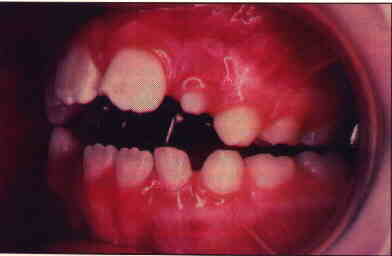

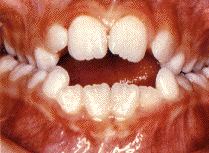
The above photograph allows a better view of the posterior (rearward) pattern typically found in the hard sucking Thumbsucker. You see that the inner pull of the cheeks due to the sucking action forced an accommodation in which the posterior teeth pushed in toward the tongue. In fact the uppers pushed in so far that they are actually further in then the lowers, hence the term "cross bite". There is no doubt that the owner of this mouth can suck their thumb effortlessly for many hours at a time.
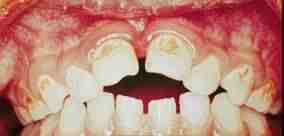
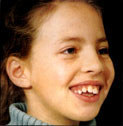
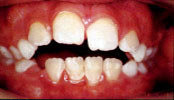 Here's
an example both via dental photography and via full face shots of what one
can look forward to as the dentition adapts to long hours sucking the
right thumb. Of course it also depends on style. Notice the open bite
favoring the right side.
Here's
an example both via dental photography and via full face shots of what one
can look forward to as the dentition adapts to long hours sucking the
right thumb. Of course it also depends on style. Notice the open bite
favoring the right side.
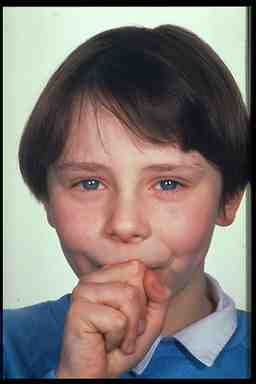
 <At
least his finger won't hurt now!
<At
least his finger won't hurt now!
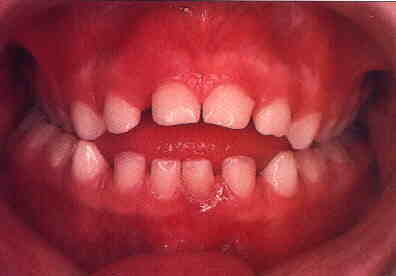
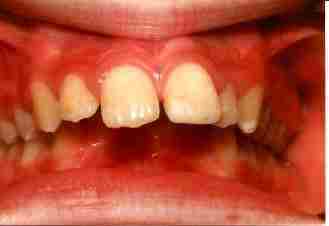 This occlusion is unusual due to the
lack of an open bite. Apparently the pressure was mostly forward with most of
the upward push on the roof of the palette, none on the dental structure itself.
This occlusion is unusual due to the
lack of an open bite. Apparently the pressure was mostly forward with most of
the upward push on the roof of the palette, none on the dental structure itself.
If you have pictures of your own thumbsucker's teeth and/or if you have any interesting teeth stories, please submit them for publication. Anonymity is assured if requested.
Black & White Contributions of Thumbsucker's Teeth
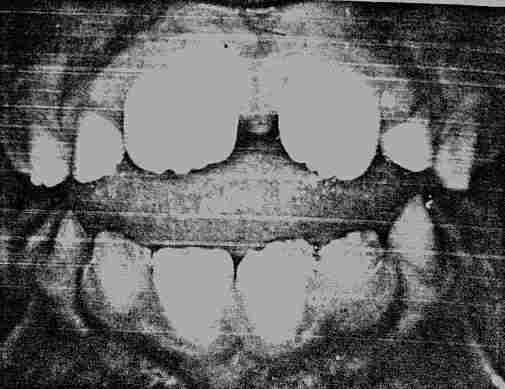
 <Result
of finger sucking here.
<Result
of finger sucking here.
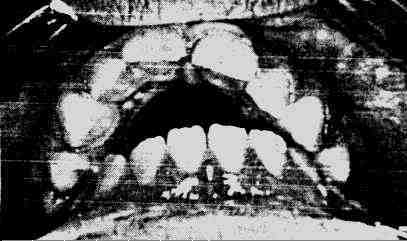 <<Could you guess which thumb?
<<Could you guess which thumb?
(Above) Notice the skewing towards the side of the thumb and the protrusion forward?
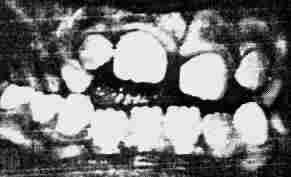 <<What you get
with two fingers instead.
<<What you get
with two fingers instead.
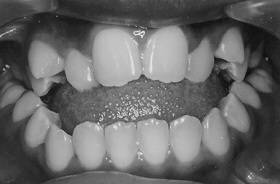
Read the contents of this page and you're still not satiated? Check out more teeth by clicking below:
E-Mail for contributions by clicking here.
Illustrations:
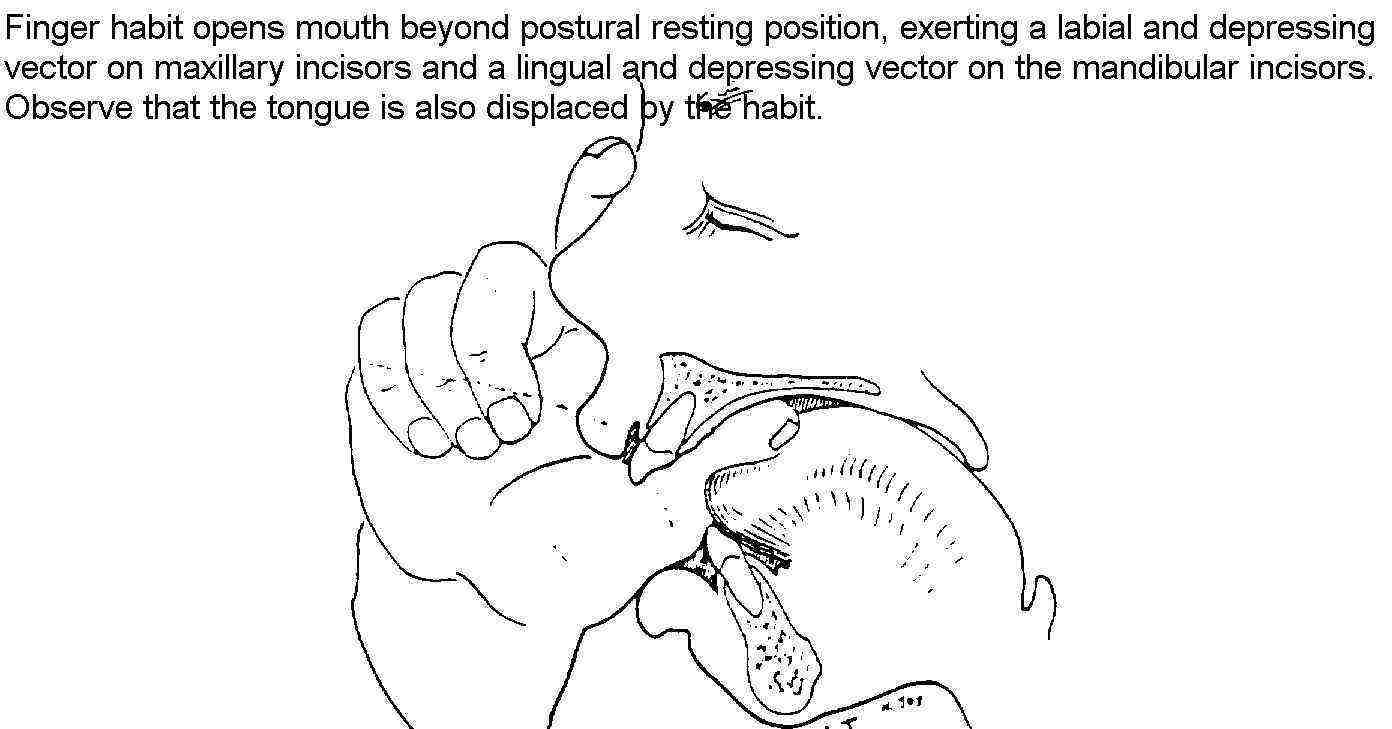
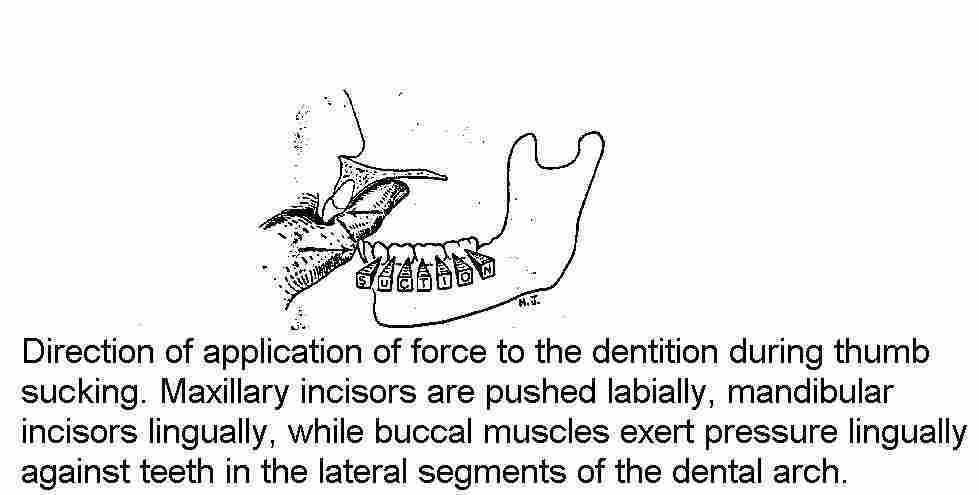
Does digit sucking cause malocclusion?.
Many children who practice digital sucking habits have no evidence of malocclusion; however, Popovich has reported a high association of abnormal sucking habits with the malocclusion sample at the Burlington Orthodontic Research Centre in Ontario, Canada. Cook measured the forces of thumb-sucking, finding three distinctly different patterns of force application during sucking all utilizing forces sufficiently strong to displace teeth or deform growing bone.
It should be remembered that the type of malocclusion that may develop in the thumb sucker is dependent on a number of variables, the position of the digit, associated orofacial muscle contractions, the position of the mandible during sucking, the facial skeletal pattern of the force applied to the teeth and alveolar process, the frequency and duration of sucking and so forth.
An anterior open bite is the most frequent malocclusion. Protraction of the maxillary anterior teeth will be seen particularly if the pollex is held upward against the palate. Mandibular postural retraction may develop if the weight of the hand or arm continually forces the mandible to assume retruded position in order to practice the habit. Concomitantly, the mandibular incisors may be tipped lingually. When the maxillary incisor have been tipped labially and an open bite has developed, it becomes necessary for the tongue to thrust forward during swallowing in order to effect an anterior seal. During thumb-sucking, buccal wall contractions produce, in some sucking patterns; a negative pressure within the mouth, with resultant narrowing of the maxillary arch. With this upsetting the force system in and around the maxillary complex, it often is impossible for the nasal floor to drop vertically to its expected position during growth. Therefore, thumb-suckers may be found to have a narrower nasal floor and a high palatal vault. The maxillary lip becomes hypotonic and the mandibular lip becomes hyperactive, since it must be elevated by contractions of the orbicularis muscle to a position between the malposed incisors during swallowing. These abnormal muscle contractions during sucking and swallowing stabilize the deformation.
Some malocclusions arising from sucking habits may be self-corrective on cessation of the habit; for example, the skeletal pattern is normal, the habit is stopped early, the deformation has been mild, there is a teeth-together swallow and the associate neuromuscular habits are of a mild nature. Unfortunately, many thumb suckers produce malocclusions that require orthodontic therapy.
And, from ancient Egypt (!)....(ancient Egypt?)
Prognathous maxilla (buckteeth) were noted in several mummies by Wente and Harris in their _X-Ray Atlas_ and in _X-Raying the Pharaohs_, and noted that such malocclusions occur due to extended thumb sucking habits, which is definitely attested to as a cultural habit among children of the ancient Egyptians, and is in fact, a "symbol" of childhood in Egyptian art. They also noted that Harris' study of modern Nubian children indicated the same rationale (extended thumb sucking and tongue thrusting) accounted for the buckteeth there as well. IOW, neither Harris or Wente lay the development of prognathous maxilla to any "racial" feature, but due to cultural habits of the cultures of Nubia (ancient and modern) and ancient Egypt that allowed long-term thumb sucking among the young.